Community Resilience Governance on Public Health Crisis in China
Abstract
:1. Introduction
2. Conceptual Framework
3. Data Sources and Research Methodology
4. Main Findings
4.1. Weak Resilience: Disadvantages of the Community Public Health Crisis Governance Model
4.1.1. “Simply Isolating Households and Communities”: Duan Lu Feng Men
In early February, Xiao Wu’s family got back to their hometown from abroad. According to local government requirements, Xiao Wu’s family needed to segregate themselves at home for 14 days. However, during the isolation, Xiao Wu found that the community resident committee had blocked the door of her house with iron chains without approval, which made Xiao Wu feel very panicked. She believed that if there was a fire or other crisis, it would be hard for the family to get away.(personal communication)
4.1.2. “Blindly Setting Limits”: Yi Wei She Xian
4.1.3. “Layer-by-Layer Law”: Ceng Ceng Jia Ma
According to Xiao Zheng’s recall, on February 15th of 2020, he provided three types of certificates when he came out of his hometown in the countryside and when he wanted to return to the city where he worked, he likewise expected to provide five types of certificates. Some of these certificates were difficult to handle, and he even needed to utilize his personal relationships to do it.(personal communication)
4.1.4. “Rejecting and Repelling all Individuals from or even Related to Hubei”: Fang E Ju E
4.2. Diagnosis of the Disadvantages in Public Health Crisis Governance Model from Grassroots Communities
4.2.1. Blurred Government–Community Relationship: Community Public Health Crisis Governance Lacks Autonomy
Xiao Fang is a staff member of the community committee. In the prevention and control of the COVID-19, she was mainly responsible for the purchase of living materials for community residents. However, the protective materials in the community were in short supply at the early stage of the epidemic, and even the staff members lacked fundamental defensive gear, such as protective clothing and masks. Xiao Fang can just utilize her raincoat to make her own defensive clothing for temporarily convenience, but the defensive effect was restricted.(personal communication)
4.2.2. Insufficient Interaction between Communities, Social Organizations, and Social Workers: Lack of Synergy in the Community Public Health Crisis Governance
Xiao Li is in charge of a social organization. After the outbreak of the COVID-19, Xiao Li immediately contacted the local community and wanted to participate in the prevention and control of the epidemic in the community as soon as possible. However, due to the absence of corresponding participation channels and institutional arrangements, Xiao Li’s social organization is temporarily incapable to enter the community to carry out its work, and even if it enters the community, it must obey the command and arrangement of the community resident committee before it can work.(personal communication)
As a community worker, Xiao Xu usually needs to deal with family conflicts in daily work. However, in the process of fighting against the COVID-19, Xiao Xu faced more psychological assistance and relief problems for residents. Xiao Xu lacked professional knowledge and practical experience in this aspect, and sometimes she felt that it was difficult to provide effective assistance for the residents.(personal communication)
4.2.3. Stagnant Involution in Community Participation: Community Public Health Crisis Governance Lacks Initiative
Xiao He is principally responsible for carrying out various activities in the community, among which public health emergency drills account for a relatively small proportion of the total activities in the community, and Xiao He admitted that most of these activities are to cope with the inspections of superiors, and sometimes as long as the drills are carried out according to the set procedures, the work can basically be completed.(personal communication)
Speaking of the COVID-19 outbreak at the end of January 2020, Xiao Zhao believed that the epidemic did expose her absence of knowledge in health protection. Since many residents like herself believed that the epidemic would soon be over under the strong response measures of the Chinese government, but some of her relatives lost their lives in the epidemic due to their disregard of self-protection, which made her realize the importance of mastering the ability of public health protection.(personal communication)
Xiao Ma has lived in the community for five years, but he infrequently chats with his neighbors and is generally unfamiliar with them. Despite the community organizing residents to participate in the epidemic prevention and control work in February, Xiao Ma did not participate in voluntary epidemic prevention activities because he was unfamiliar with the interpersonal situation in the community.(personal communication)
5. Conclusions
Author Contributions
Funding
Institutional Review Board Statement
Informed Consent Statement
Data Availability Statement
Acknowledgments
Conflicts of Interest
References
- Ministry of Emergency Management of the People’s Republic of China. Basic Situation of Natural Disasters in China in 2019. 2020. Available online: https://www.mem.gov.cn/xw/bndt/202001/t20200116_343570.shtml (accessed on 11 October 2020).
- World Health Organization. Summary of Probable SARS Cases with Onset of Illness from 1 November 2002 to 31 July 2003. 2003. Available online: https://www.who.int/csr/sars/country/table2004_04_21/en/ (accessed on 11 October 2020).
- National Health Commission of the People’s Republic of China. Epidemic Situation of Notifiable Infectious Diseases in China in 2014. 2015. Available online: http://www.nhc.gov.cn/jkj/s6873/201502/847c041a3bac4c3e844f17309be0cabd.shtml (accessed on 11 October 2020).
- National Health Commission of the People’s Republic of China. Up to 24 January 9th Novel Coronavirus Pneumonia Epidemic Situation. 2021. Available online: http://www.nhc.gov.cn/xcs/yqfkdt/202102/81f4ea8fc1f74ed0a6ef5b8a88501030.shtml (accessed on 6 February 2021).
- Luhmann, N. Risk: A Sociological Theory; De Gruyter: Berlin, Germany, 1993. [Google Scholar]
- Cao, H.J.; Liang, S. The “Fine Control” Way of Community Public Health Emergency Management—Realistic Dilemma, Logical Reasoning and Governance Strategy. Theor. Discuss. 2020, 3, 149–157. [Google Scholar]
- Ge, M.; Chen, X.P.; Wu, F.P. Dynamic allocation of disaster chain, uncertain supply and demand and complex emergency resource allocation network. Res. Sci. Technol. Manag. 2017, 13, 205–214. [Google Scholar]
- Holland, J.H. Hidden Order: How Adaptation Builds Complexity; Addison-Wesley: Reading, MA, USA, 1995. [Google Scholar]
- Morin, E. Le Paradigme Perdu: La Nature Humaine; Editions du Seuil: Paris, France, 1973. [Google Scholar]
- Prigogine, I.; Stengers, I. Order Out of Chaos: Man’s New Dialogue with Nature; Flamingo Edition: London, UK, 1984. [Google Scholar]
- Gell-Mann, M. The Quark and the Jaguar. Adventures in the Simple and the Complex; Freeman W.H. and Company: New York, NY, USA, 1994. [Google Scholar]
- Dooley, K. A Nominal Definition of Complex Adaptive Systems. Chaos Netw. 1996, 1, 2–3. [Google Scholar]
- Cowan, G.A. Complexity: Metaphors, Models and Reality; Addison—Wesley Publishing Company: Reading, MA, USA, 1994. [Google Scholar]
- Tay, N.S.P.; Lusch, R.F. Agent-Based Modeling of Ambidextrous Organizations: Virtualizing Competitive Strategy. Intell. Syst. 2007, 5, 50–57. [Google Scholar] [CrossRef]
- Stacey, R.D. Complexity and Creativity in Organization; Berrett-Koehler Publishers: San Francisco, CA, USA, 1996. [Google Scholar]
- National Health Commission of the People’s Republic of China. Bulletin of Epidemic Situation of COVID-19. 2020. Available online: http://www.nhc.gov.cn/xcs/yqtb/list_gzbd.shtml (accessed on 6 February 2021).
- National Bureau of Statistics of China. China Statistical Yearbook-2020. 2020. Available online: http://www.stats.gov.cn/tjsj/ndsj/2020/indexch.htm (accessed on 6 February 2021).
- Baidu Map. Trend of China’s Population Mobility. 2020. Available online: https://qianxi.baidu.com/ (accessed on 6 February 2021).
- Rosenthal, U.; Charles, M.T. Coping with Crises: The Management of Disasters, Riots and Terrorism; Charles C. Thomas Publisher: Springfield, IL, USA, 1989. [Google Scholar]
- Xu, W.Q. Under the Epidemic Situation, the “Hard Core” Prevention and Control in Northern Rural Areas. 2020. Available online: http://www.time-weekly.com/post/267333 (accessed on 11 October 2020).
- Zwęgliński, T. Fire and Rescue Units During COVID-19 Epidemic. Operational Functioning and Tasks in the First Months of SARS-CoV-2 activity. Zesz. Nauk. SGSP 2020, 76, 93–114. [Google Scholar] [CrossRef]
- Ministry of Public Security of the People’s Republic of China. The First Meeting of the Leading Group of the Ministry of Public Security to Deal with COVID-19 Epidemic. 2020. Available online: https://www.mps.gov.cn/n2253534/n2253535/c7099765/content.html (accessed on 11 October 2020).
- Joint Prevention and Control Mechanism of the State Council. Guidance on COVID-19 Epidemic Prevention and Control through Scientific Prevention, Precise Implementation and District Classification. 2020. Available online: http://www.gov.cn/xinwen/2020-02/18/content_5480514.htm (accessed on 11 October 2020).
- Beijing, Tianjin, Hebei Strategy. Report of Epidemic Situation. 2020. Available online: https://kuaibao.qq.com/s/20200226A08VVN00?refer=spider (accessed on 11 October 2020).
- Chen, B. “Secondary Disaster” Caused by Rigid Prevention and Control and Its Governance. 2020. Available online: https://www.thepaper.cn/newsDetail_forward_6998254 (accessed on 11 October 2020).
- Joint Prevention and Control Mechanism of the State Council. On February 25, the State Council Held a Press Conference on Joint Prevention and Control Mechanism. 2020. Available online: http://www.gov.cn/xinwen/gwylflkjz30/mobile.htm (accessed on 11 October 2020).
- He, X.F. Investigation Report from 98 Counties of 14 Provinces: Industrial Workers Frozen by Local Epidemic Prevention and Control. 2020. Available online: https://mp.weixin.qq.com/s/iBQlVriZOF3ESoier_ArEg (accessed on 11 October 2020).
- Joint Prevention and Control Mechanism of the State Council. Special Topic of Resumption of Work and Production Services. 2020. Available online: http://www.gov.cn/fuwu/zhuanti/fgfclm/zcgj.htm (accessed on 11 October 2020).
- Central People’s Government of the People’s Republic of China. Joint Prevention and Control Mechanism of the State Council. 2020. Available online: http://www.gov.cn/zhengce/gwylflkjzwj.htm (accessed on 11 October 2020).
- Xu, D.W. Health Code Is Raised without Restriction at Various Levels, Is It Really so Difficult to Recognize each Other in the Country? 2020. Available online: https://www.chinanews.com/gn/2020/04-28/9170116.shtml (accessed on 11 October 2020).
- Xu, G.Z.; Gu, J.F.; Che, H.A. System Science; Shanghai Science and Technology Education Press: Shanghai, China, 2000. [Google Scholar]
- Chinese People’s Congress. Constitution of the People’s Republic of China. 2020. Available online: http://www.gov.cn/govweb/test/2005-06/14/content_6310.htm (accessed on 11 October 2020).
- Chen, Y.; Guo, C.Q. Urban community governance in China: Dilemma, causes and countermeasures. J. Suzhou Univ. (Philos. Soc. Sci.) 2016, 6, 36–41. [Google Scholar]
- Zhou, Q.Z. On China’s Community Governance: Transformation from authoritarian governance to participatory governance. Learn. Explor. 2016, 6, 38–47, 159. [Google Scholar]
- Li, Y.X.; Zhou, J.P. Empowerment: Realistic Dilemma and two-way construction strategy of community governance modernization. J. Cult. 2020, 3, 13–16. [Google Scholar]
- Ye, L.H. Integration and sharing of public resources in urban communities. Chongqing Soc. Sci. 2016, 12, 39–46. [Google Scholar]
- He, H.B. The main problems of the management system of urban communities in my country and the reform trend. J. Shanghai Adm. Inst. 2007, 2, 55–60. [Google Scholar]
- Hou, L.W. Administration absorbs society: State penetration and administration of neighborhood committees. J. Shenzhen Univ. (Humanit. Soc. Sci. Ed.) 2019, 2, 112–121. [Google Scholar]
- Xinhua Finance. Strengthen Property Management and Build a “Safety Line” for Community Epidemic Prevention and Control. 2020. Available online: http://thinktank.xinhua08.com/a/20200218/1914770.shtml (accessed on 11 October 2020).
- Yang, G.H. Community, Social Organizations, Social Workers to Help Grassroots Social Services and Social Governance Research-Based on the Survey of Xiamen City. Dev. Res. 2015, 11, 85–89. [Google Scholar]
- Chen, S.; Chen, T.; Du, B.G.; Li, Y.S.; Zhang, H.; Zhao, F.; Zhu, X.N. Prevention and Control of COVID-19 pandemic: Problems, Countermeasures and Enlightenment. Governance 2020, 5, 16–20. [Google Scholar]
- Zhu, L.R. Re-improvement of community governance from epidemic prevention and control. J. Liaoning Adm. Coll. 2020, 4, 44–47. [Google Scholar]
- Xinhua Net. There Are 393,000 Community Social Organizations in China. 2020. Available online: http://www.xinhuanet.com/fortune/2018-11/22/c_1123754433.htm (accessed on 11 October 2020).
- Wen, J. The Role Dilemma and Outlet of the Development of Chinese Social Organizations. J. Jiangsu Adm. Inst. 2012, 1, 57–61, 67. [Google Scholar]
- Yu, H.L.; Li, Q.L. Practical Dilemma and Optimization Path of Social Organizations Participating in Community Governance. China Natl. Cond. Strength 2019, 4, 27–30. [Google Scholar]
- Zeng, Y.H. Current Development Dilemma and System Reconstruction in Chinese social organizations. Seek. Truth 2013, 3, 99–106. [Google Scholar]
- Wuhan Federation of Social Work. Organizing Social Workers to the COVID-19. 2020. Available online: http://www.zsswdf.org/content/2523 (accessed on 11 October 2020).
- Gu, D.H. A Survey of Social Workers in the Epidemic. 2020. Available online: https://www.thepaper.cn/newsDetail_forward_6583427 (accessed on 11 October 2020).
- Zhang, J.J.; Wang, W.J. Research on the Professional Ability and Development Path of Contemporary Chinese Social Workers. Soc. Work Manag. 2017, 1, 66–72. [Google Scholar]
- Yue, J. Research on the Status Quo and Countermeasures of Urban Community Emergency Management. Theor. Constr. 2013, 6, 96–98. [Google Scholar]
- National Health Commission. Report on the Development of Floating Population in China, 2018. 2018. Available online: http://www.nhc.gov.cn/wjw/xwdt/201812/a32a43b225a740c4bff8f2168b0e9688.shtml (accessed on 11 October 2020).
- National Bureau of Statistics. Statistical Bulletin of China’s National Economic and Social Development in 2019. 2020. Available online: http://www.stats.gov.cn/tjsj/zxfb/202002/t20200228_1728913.html (accessed on 11 October 2020).
- Dong, H. Space, risk, and modernization of mega-cities governance: Thinking based on the COVID-19. J. China Univ. Min. Technol. (Soc. Sci. Ed.) 2021, 1, 1–10. [Google Scholar]
- Norris, F.H.; Stevens, S.P.; Pfefferbaum, B.; Wyche, K.F.; Pfefferbaum, R.L. Community Resilience as a Metaphor, Theory, Set of Capacities, and Strategy for Disaster Readiness. Am. J. Community Psychol. 2008, 41, 127–150. [Google Scholar] [CrossRef]
- Rothsteinb, B. Just Institutions Matter: The Moral and Political Logic of the Welfare State; Cambridge University Press: New York, NY, USA, 1998. [Google Scholar]
- Sun, L.; Liu, T. Injured but not entitled to legal insurance compensation ornamental institutions and migrant workers’ informal channels in China. Soc. Policy Adm. 2015, 48, 905–922. [Google Scholar] [CrossRef]
- Wang, C.; Liu, T. Family separation, ritual system and physical abuse: A survey of left behind children in rural China. Xinjiang social science. XinJiang Soc. Sci. 2018, 1, 148–157, 168. [Google Scholar]
- Wang, C.; Tang, J.Y. Ritualized law and livelihood fragility of left-behind women in rural China. Int. J. Environ. Res. Public Health 2020, 17, 4323. [Google Scholar] [CrossRef] [PubMed]
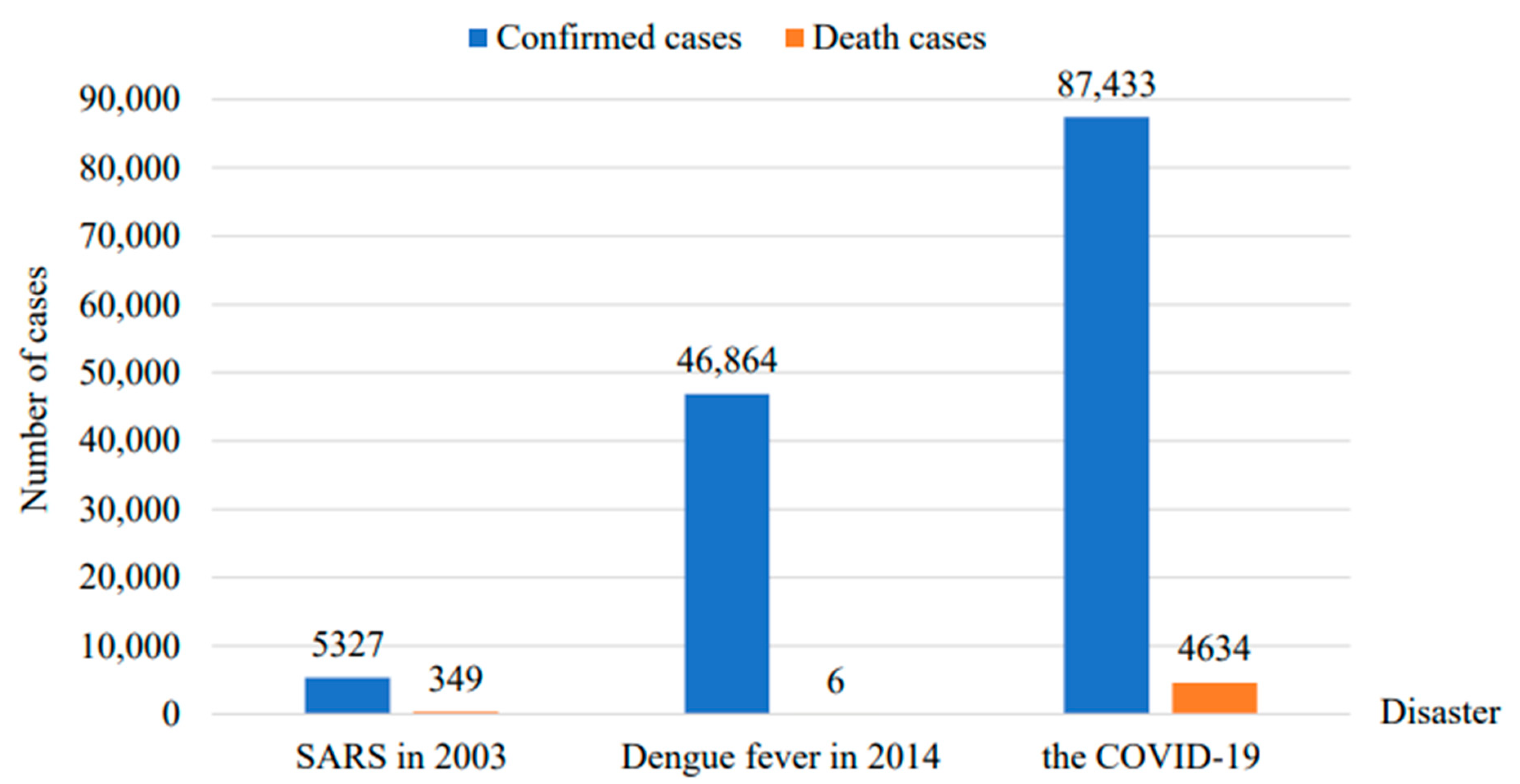
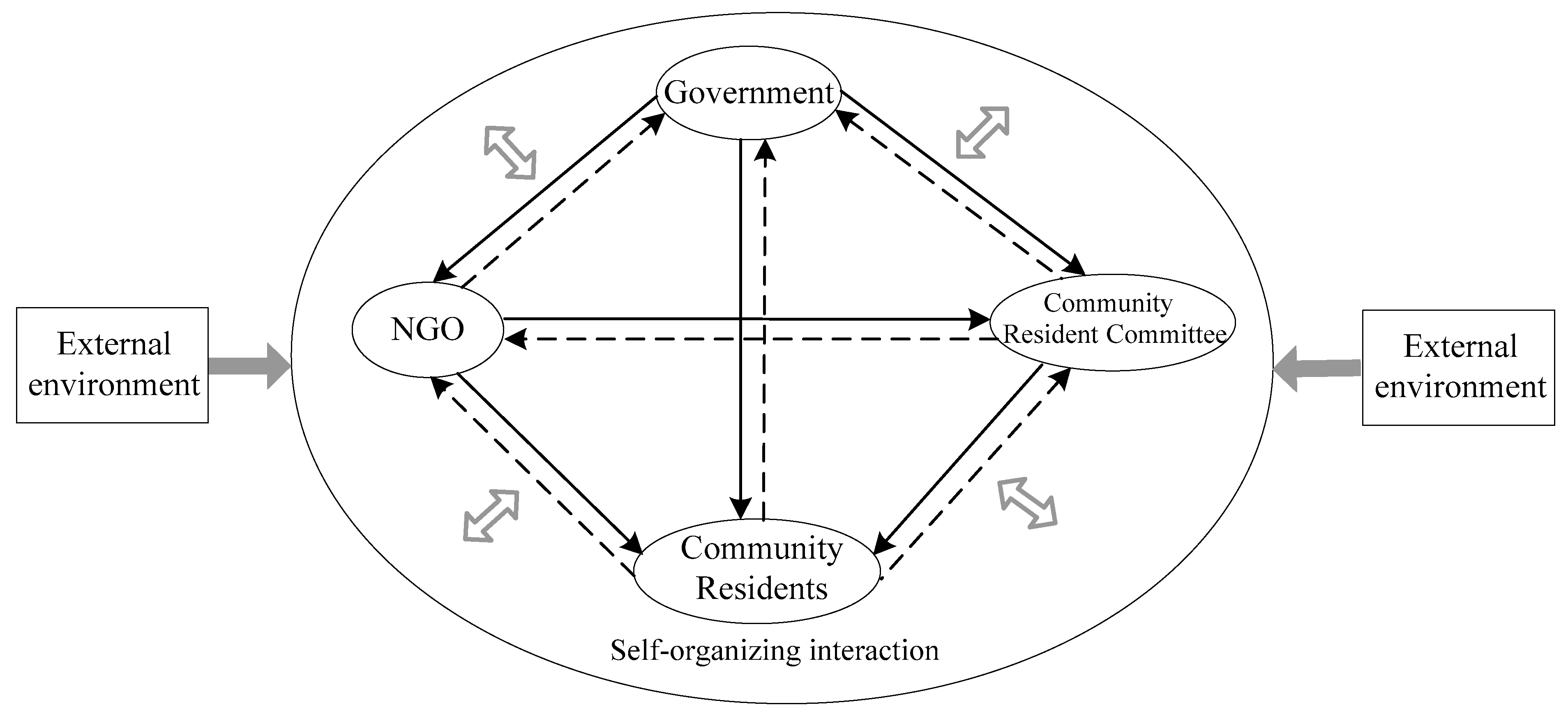
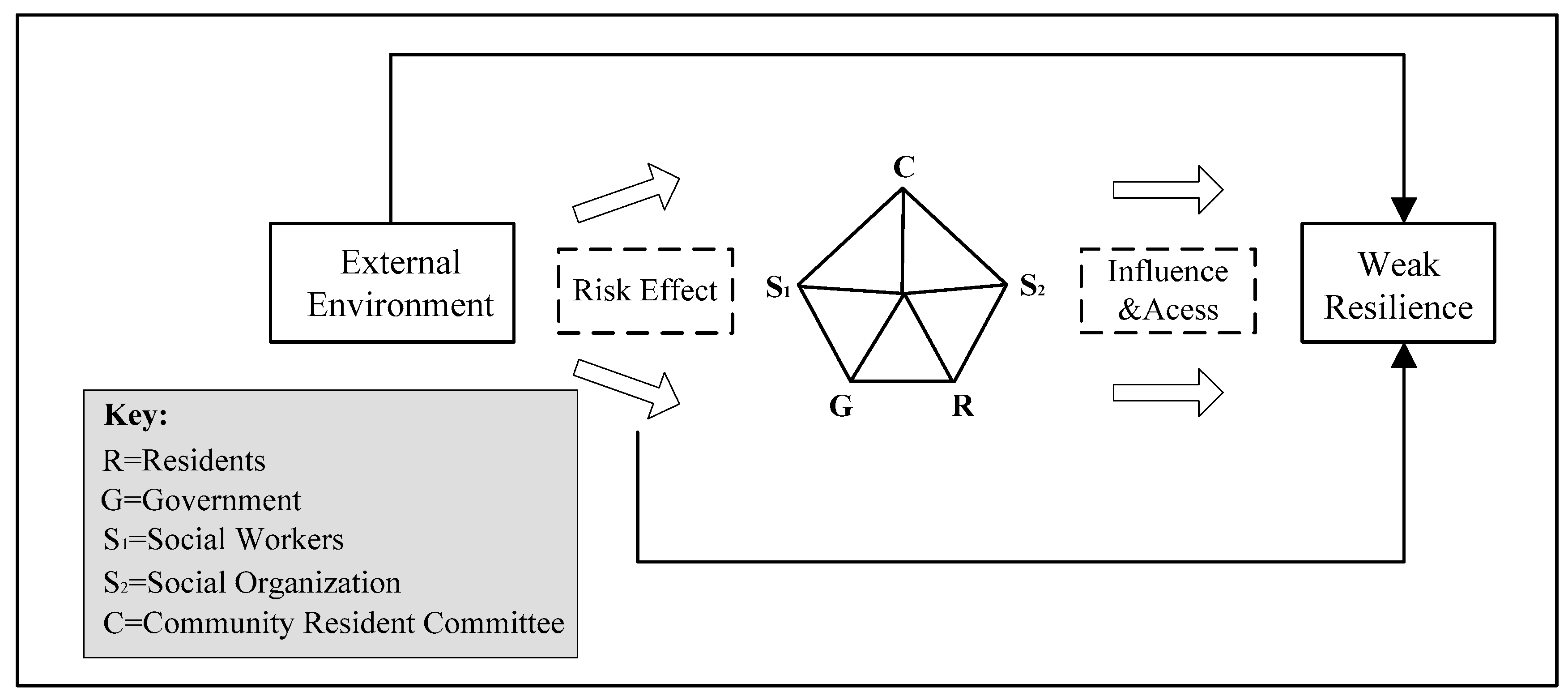
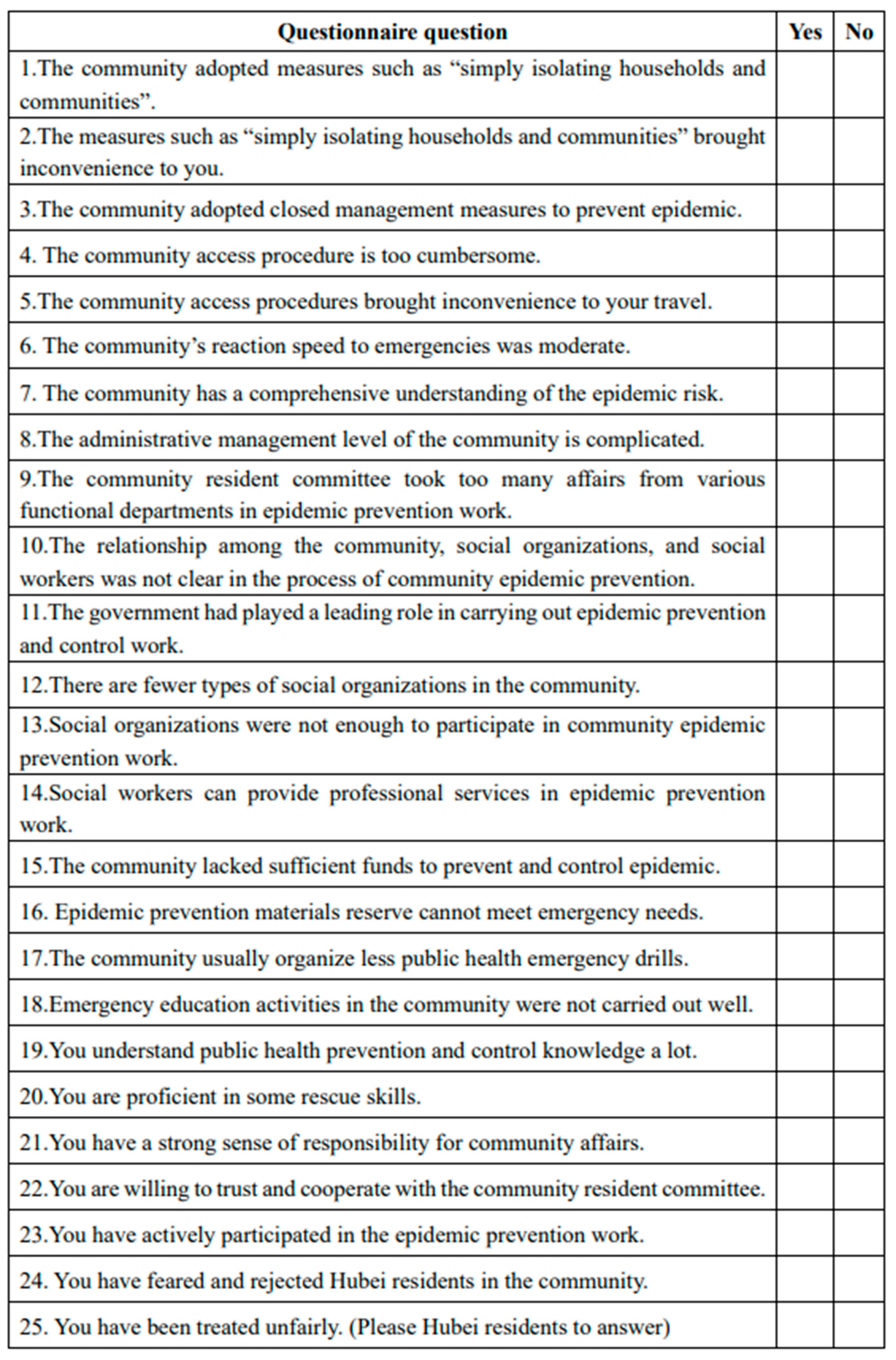
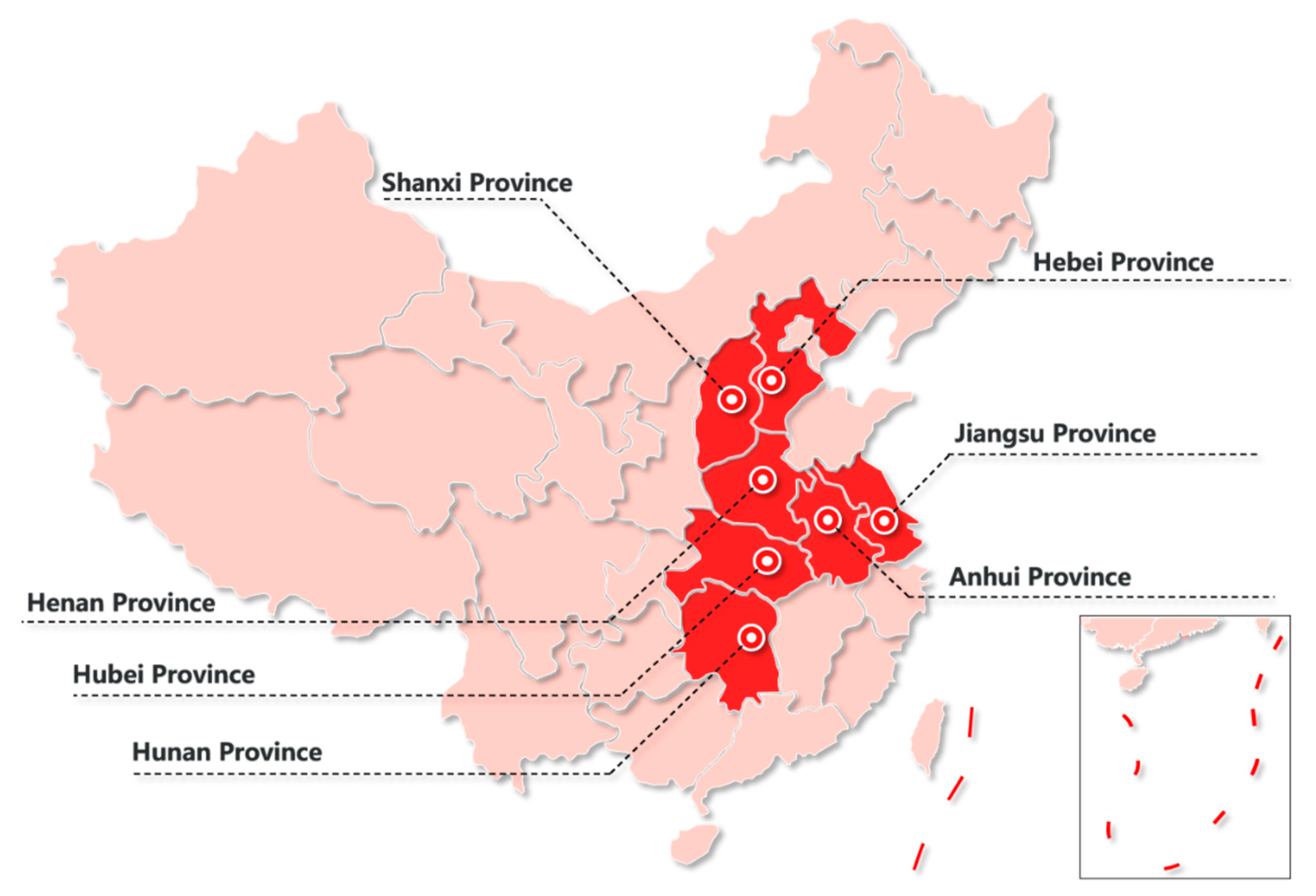

| Variables | Option | N | P | SD |
|---|---|---|---|---|
| “hard core” control measures | Yes | 757 | 32.3 | 0.889 |
| No | 1588 | 67.7 | ||
| bring inconvenience | Yes | 908 | 38.7 | 0.939 |
| No | 1437 | 61.3 | ||
| adopted closed management measures | Yes | 755 | 32.2 | 0.917 |
| No | 1590 | 67.8 | ||
| lack flexibility | Yes | 884 | 37.7 | 0.908 |
| No | 1461 | 62.3 | ||
| quick reaction | Yes | 1529 | 65.2 | 0.919 |
| No | 816 | 34.8 | ||
| the government play a leading role | Yes | 1726 | 73.6 | 0.934 |
| No | 619 | 26.4 | ||
| social organizations’ participation | Yes | 1588 | 67.7 | 0.944 |
| No | 757 | 32.3 | ||
| diversity of social organization | Yes | 1569 | 66.9 | 0.888 |
| No | 776 | 33.1 | ||
| social workers provide professional service | Yes | 1705 | 72.7 | 0.953 |
| No | 640 | 27.3 | ||
| public health emergency drills | Yes | 884 | 37.7 | 1.014 |
| No | 1461 | 62.3 | ||
| emergency education activities | Yes | 1367 | 58.3 | 0.892 |
| No | 978 | 41.7 | ||
| public health knowledge | Yes | 1700 | 72.5 | 0.890 |
| No | 645 | 27.5 | ||
| rescue skills | Yes | 1496 | 63.8 | 0.858 |
| No | 849 | 36.2 | ||
| sense of responsibility | Yes | 1571 | 67.0 | 0.925 |
| No | 774 | 33.0 | ||
| show cooperation | Yes | 1660 | 70.8 | 0.921 |
| No | 685 | 29.2 | ||
| epidemic prevention participation | Yes | 1552 | 66.2 | 0.913 |
| No | 793 | 33.8 | ||
| complicated management level | Yes | 1137 | 48.5 | 0.913 |
| No | 1208 | 51.5 | ||
| excessive administrative affairs | Yes | 739 | 31.5 | 0.911 |
| No | 1606 | 68.5 |
Publisher’s Note: MDPI stays neutral with regard to jurisdictional claims in published maps and institutional affiliations. |
© 2021 by the authors. Licensee MDPI, Basel, Switzerland. This article is an open access article distributed under the terms and conditions of the Creative Commons Attribution (CC BY) license (http://creativecommons.org/licenses/by/4.0/).
Share and Cite
Wang, C.; Dong, X.; Zhang, Y.; Luo, Y. Community Resilience Governance on Public Health Crisis in China. Int. J. Environ. Res. Public Health 2021, 18, 2123. https://doi.org/10.3390/ijerph18042123
Wang C, Dong X, Zhang Y, Luo Y. Community Resilience Governance on Public Health Crisis in China. International Journal of Environmental Research and Public Health. 2021; 18(4):2123. https://doi.org/10.3390/ijerph18042123
Chicago/Turabian StyleWang, Chao, Xuan Dong, Yan Zhang, and Yiwen Luo. 2021. "Community Resilience Governance on Public Health Crisis in China" International Journal of Environmental Research and Public Health 18, no. 4: 2123. https://doi.org/10.3390/ijerph18042123
APA StyleWang, C., Dong, X., Zhang, Y., & Luo, Y. (2021). Community Resilience Governance on Public Health Crisis in China. International Journal of Environmental Research and Public Health, 18(4), 2123. https://doi.org/10.3390/ijerph18042123





